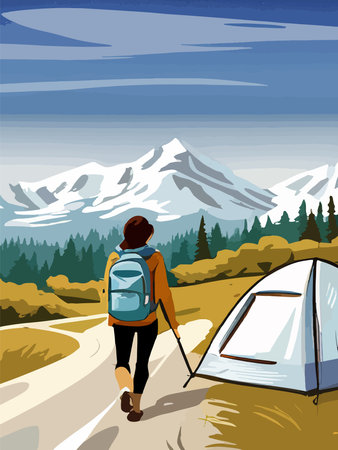Understanding Endangered Species in the United States
When planning a camping trip in America’s breathtaking outdoors, it’s important to understand what it means for a species to be endangered and why this matters for families exploring nature together. In the United States, an endangered species is one that is at serious risk of extinction throughout all or a significant portion of its range. This can include both animals and plants, from the majestic Florida panther roaming southern woodlands to delicate wildflowers like the Kentucky lady’s slipper hiding in shaded forests.
America’s national parks, forests, and wilderness areas are home to a remarkable variety of habitats—deserts, mountains, wetlands, prairies, and coastal shores. While camping, you might encounter rare creatures such as the California condor soaring overhead or hear the distant call of a red wolf in the southeast. Unique plant life like saguaro cacti or ancient bristlecone pines also depend on respectful visitors to help them thrive.
Learning about endangered species before your trip not only enriches your family’s experience but also fosters a sense of stewardship toward these vulnerable neighbors. By understanding which species are protected and why they matter, campers can take thoughtful steps to enjoy the outdoors without causing harm. Whether you’re roasting marshmallows by the lake or hiking through old-growth forests, being mindful of local wildlife helps ensure these special animals and plants will be around for generations to come.
2. Why Responsible Camping Matters
When camping near endangered species, our actions can have a significant effect on these vulnerable animals and their habitats. Human activities, even those that seem harmless like pitching a tent or taking a hike, can disrupt natural behaviors essential to the survival of these species. Its important for families and individuals to understand that minimizing our impact isnt just about following rules—its about protecting fragile populations for future generations.
For example, noise, light pollution, and improper waste disposal can all disturb wildlife. Animals may abandon nests, alter feeding patterns, or become stressed by unfamiliar scents and sounds. These disturbances can be especially harmful during critical times such as breeding or migration seasons.
| Human Activity | Potential Impact on Wildlife | Best Practice |
|---|---|---|
| Loud noises (music, shouting) | Startles animals; may cause nest abandonment | Keep voices low; avoid loud devices |
| Leaving food out | Attracts predators; disrupts local food chain | Store food in wildlife-proof containers |
| Campsite lighting at night | Disorients nocturnal species; interrupts natural cycles | Use minimal, shielded lights only when necessary |
| Straying off marked trails | Damages sensitive habitats; tramples plants used by endangered species | Stay on designated paths and campsites |
| Littering or improper waste disposal | Pollutes environment; harms animals if ingested | Pack out all trash; use proper restroom facilities or follow Leave No Trace principles |
By being mindful of our camping habits, we help ensure that endangered species have the best possible chance to thrive. Responsible camping is not only an ethical responsibility but also a meaningful way to teach children respect for nature and stewardship of the planet.

3. Planning Your Trip: Research and Preparation
Before heading out on your camping adventure near endangered species habitats, it’s essential to do your homework. Responsible planning not only protects wildlife but also ensures a safe and enjoyable experience for your family.
Identify Protected Areas
Start by researching the area you wish to visit. The U.S. has many protected lands, such as national parks, wildlife refuges, and conservation areas, where endangered species may live. Visit official websites like the National Park Service or U.S. Fish & Wildlife Service to learn about any special considerations or boundaries. Look for updated maps that mark off-limits zones and sensitive habitats.
Check Camping Regulations
Each location may have its own set of rules regarding camping, especially in regions where rare plants or animals are found. Always check local regulations before booking your trip—some places only allow camping in designated spots, while others require permits to limit the number of visitors at any one time. These guidelines help reduce human impact on fragile ecosystems and protect the animals that call these places home.
Choose Low-Impact Campsites
When selecting your campsite, opt for established sites rather than creating new ones. Established campsites are designed to concentrate foot traffic and minimize disturbance to nearby plants and animals. If you’re backpacking or dispersed camping, pick a spot at least 200 feet away from water sources to avoid disrupting wildlife that depend on streams or lakes for survival. Remember: Leave No Trace principles are key—pack out everything you bring in, and leave natural objects as you found them.
Practical Tips for Families
- Involve kids in researching endangered species found near your chosen campsite—it’s a great learning opportunity!
- Download trail maps and regulations to your phone ahead of time, since some remote areas may lack cell service.
- Reach out to park rangers for advice—they’re happy to share insights about current conditions or sensitive zones.
By planning ahead with care and curiosity, you’ll set the stage for a meaningful outdoor experience that respects both nature and its most vulnerable inhabitants.
4. Leave No Trace Principles for Sensitive Habitats
When camping near endangered species, it’s crucial to follow the Leave No Trace (LNT) principles. These guidelines aren’t just about keeping campsites clean—they’re about protecting fragile habitats and respecting the wildlife that calls them home. Below, you’ll find actionable advice on how to pack, set up camp, and manage your daily routines in ways that actively support conservation efforts and model ethical behavior for your family.
Packing with Conservation in Mind
| Packing Tip | Why It Matters |
|---|---|
| Use reusable containers and utensils | Reduces single-use plastics that can harm wildlife if littered |
| Bring eco-friendly soaps and toiletries | Prevents water pollution in sensitive streams and lakes |
| Pack out all trash—including food scraps | Ensures animals aren’t attracted to human food or waste |
| Avoid packing invasive plant seeds (like hay for pets) | Prevents the spread of harmful non-native species |
Setting Up Camp Responsibly
- Choose established campsites: Stick to designated areas whenever possible to avoid trampling native plants and disturbing animal homes.
- Keep a safe distance from water sources: Set up camp at least 200 feet away from lakes, rivers, or wetlands to protect aquatic habitats.
- Avoid nesting areas: Learn to identify signs of animal nests or burrows and set up far away from these sensitive zones.
- No structures or digging: Don’t dig trenches or build shelters that could damage roots or small animal habitats.
Daily Routines That Support Wildlife Conservation
| Routine | LNT Practice | Wildlife Benefit |
|---|---|---|
| Cooking & eating meals | Use camp stoves instead of open fires; keep all food sealed and stored securely. | Prevents wildfires and stops animals from accessing human food. |
| Bathroom breaks | If no toilets are available, dig a small “cat hole” at least 6-8 inches deep and 200 feet from water sources; pack out used toilet paper. | Keeps water sources clean and minimizes disease risk for wildlife. |
| Exploring trails with kids | Stay on marked paths; teach children not to pick plants or collect rocks/animals. | Protects native vegetation and reduces stress on wildlife. |
| No loud noises after dark | Use quiet voices; avoid music or bright lights at night. | Lowers disturbance to nocturnal animals’ routines. |
The Power of Example: Teaching Kids Ethical Camping Behavior
Your actions shape your children’s attitudes toward nature. By practicing Leave No Trace as a family, you show your kids what it means to respect the land and its creatures—especially those most at risk. Take time to explain why each guideline matters, encourage questions, and celebrate the little wins (like spotting an animal trail without disturbing it). Small daily choices add up to big positive impacts for endangered species and their habitats.
5. Interacting with Wildlife: Dos and Donts
When camping near endangered species, it’s important to enjoy the beauty of wildlife while respecting their space and safety. Teaching your family how to observe animals responsibly will make your camping trip both memorable and ethical.
Observe from a Distance
Always watch wildlife from a safe distance. Use binoculars or cameras with zoom lenses to get a closer look without approaching. Remind your kids not to run toward animals, make loud noises, or try to touch them—even if they seem friendly. Many endangered species are sensitive to human presence, and getting too close can stress them or disrupt their natural behaviors.
Don’t Feed the Animals
Feeding wildlife, even with good intentions, is dangerous for both animals and humans. It can cause animals to become dependent on people for food, encourage them to approach campsites, and disrupt their natural diet. Always store your food securely in sealed containers and pack out all trash to avoid attracting curious critters to your campsite.
Minimize Disturbance
Keep noise levels low and stick to established trails when hiking. Avoid shining bright lights into animal habitats at night, as this can disorient nocturnal species. If you spot nesting sites or dens, steer clear—these areas are especially sensitive, and disturbing them can put young animals at risk.
Teach Kids Respectful Habits
Share these guidelines with your children before you head out and remind them throughout your trip. Turn wildlife watching into a fun family activity by bringing a field guide and encouraging quiet observation. This not only keeps everyone safe but also teaches lifelong respect for nature.
Summary Tip:
By following these dos and don’ts when interacting with wildlife near endangered species, you help protect fragile ecosystems while giving your family a safe, rewarding outdoor experience.
6. Getting Kids Involved in Conservation
Camping near endangered species offers a unique chance to spark your child’s curiosity about the natural world and teach them the importance of conservation. By turning your outdoor adventure into a hands-on learning experience, you can help nurture a sense of stewardship in your little ones while instilling lifelong respect for wildlife and their habitats.
Make Learning Fun and Interactive
Encourage kids to observe animals quietly from a distance using binoculars, or keep a nature journal where they can sketch plants, record animal sightings, and jot down interesting facts. Try playing “wildlife bingo” or creating scavenger hunts based on local flora and fauna—activities that make learning about endangered species engaging and memorable.
Teach by Example
Children learn best by watching adults. Show them how to follow Leave No Trace principles: pack out all trash, stay on marked trails, and avoid picking plants or disturbing animal homes. Explain why these actions matter, especially when camping near sensitive habitats.
Discuss the Importance of Endangered Species
Take time around the campfire to talk about what it means for an animal or plant to be endangered. Highlight how every creature has a role in the ecosystem, and how our choices—even simple ones made during camping—can help protect these special species for future generations.
Get Involved with Local Conservation Efforts
If your campsite is near a protected area or wildlife reserve, check if there are family-friendly volunteer opportunities like habitat cleanups or citizen science projects. Participating together not only benefits local ecosystems but also reinforces positive values in children.
Encourage Questions and Curiosity
Create an open environment where kids feel comfortable asking questions about what they see and hear. Bring along age-appropriate field guides or download educational apps to help identify animals and plants, deepening their connection with nature.
By making conservation a part of your camping experience, you empower your children to become thoughtful adventurers who care for our planet—a lesson that goes far beyond any single trip.
7. What To Do If You Encounter Endangered Species
Stumbling upon an endangered animal or rare plant while camping can be both thrilling and humbling. It’s important to handle these moments with care, ensuring you protect the species and follow ethical practices. Here’s what you should do if you find yourself in this unique situation.
Keep a Safe Distance
First and foremost, maintain a respectful distance from any endangered wildlife or plants. Approaching too closely can cause unnecessary stress or even harm to these vulnerable species. Teach your children to observe quietly and avoid making loud noises or sudden movements. Remember, even well-intentioned actions like feeding animals or touching plants can disrupt their natural behaviors and habitats.
Document Your Sighting Responsibly
If you’d like to remember the encounter or help with conservation efforts, take photos from afar without using flash, which can startle animals. For plants, capture images without picking flowers or disturbing the soil around them. Record details such as the location (using GPS if possible), time of day, weather conditions, and the behavior or condition of the species observed.
Know When and Whom to Notify
Your sighting could be valuable for scientists and conservationists working to protect these species. In the United States, report your findings to local park rangers, state wildlife agencies, or organizations like the U.S. Fish & Wildlife Service. Many parks have visitor centers with staff who can assist, or you may find signage with emergency numbers. Some states also offer online reporting tools specifically for rare wildlife sightings.
Use Caution With Social Media
Sharing your experience online can be exciting, but be mindful not to disclose exact locations of endangered species, as this information could attract poachers or result in habitat disturbance from increased foot traffic.
Teach Kids Respectful Curiosity
Encourage your children to ask questions and learn more about why these species are protected and what role they play in nature. This is a wonderful opportunity for hands-on environmental education and fostering lifelong respect for our planet’s most vulnerable creatures.
Be a Steward of Nature
Your actions matter! By following these steps when encountering endangered species during your camping adventure, you’re helping ensure that future generations have a chance to experience these wonders too. Responsible campers are partners in conservation—thank you for doing your part.

